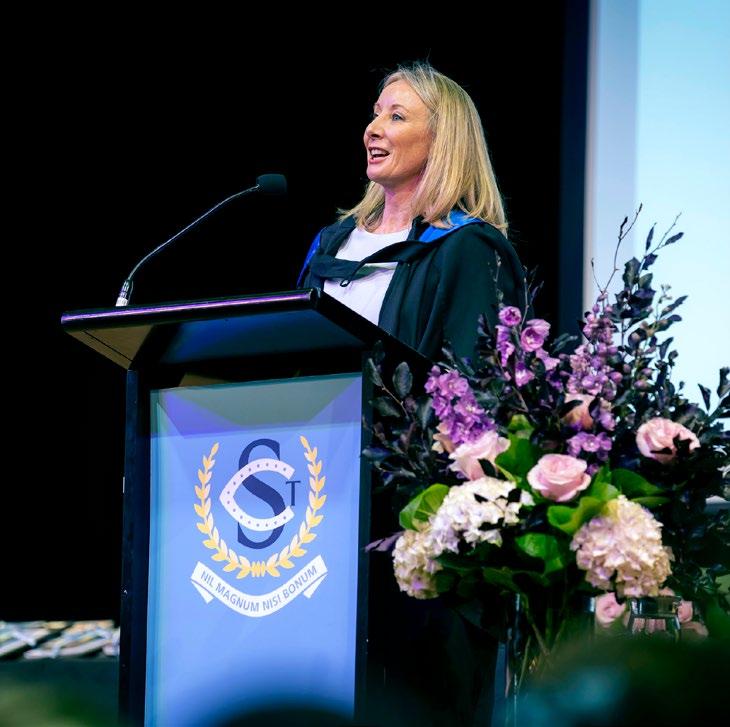
4 minute read
Mrs Ceri Lloyd Disrupting the Norms to Transform Learning
high regard, COVID schooling lifts in the teacher’s mind an increased need to check on their students’ emotional and social health. Implemented on Mondays in the Senior School is a ‘high-five’ wellbeing check-in conducted with girls by House Tutors. The check-in is a subtle and careful screening process to flag students for further follow-up by specialists, such as our School Psychologists, or simply a second conversation with Heads of Year. Our Barbreck teachers, working with their girls for greater lengths of time, also undertake the wellbeing checks throughout the day. It was soon discovered that teaching online reduced the surveillance capacity to ensure students were ‘doing’ the work, usually observed whilst walking around the classroom and peering over shoulders. COVID teaching required a switch to more of a triage approach – listening to where students were, what they were struggling with and providing feedback as ‘where to go next,’ making the lessons more like a short story with a beginning, a middle and end. Pivotal to each lesson is a need to be clear about what success looks like as they start a series of lessons, considering the efficiencies as well as effectiveness of lessons. Adopting the Goldilocks principle of challenge (not too hard, not too easy, and not too boring), combined with the integration of social and emotional health in every lesson, are some of the key learnings from COVID teaching. Australians have experienced many disasters such as fires, floods, and cyclones. Once again with COVID, there is much evidence of resilience, getting on with solving problems and looking after and helping each other. Educators have continued to show these attributes during COVID times, hence Hattie’s research title, An Ode to their Expertise. Hattie calls to all communities to “honour their expertise, their care and investment in every student and to applaud the excellence of educators. Along with nurses and doctors, teachers are among the true heroes of COVID.”
Michelle Carroll
Principal
Reference: J Hattie, 2021. An Ode to Expertise: What have we learnt from COVID teaching and how can we apply our new learning? Paper presented at the Victorian Education State Principals Conference, August 2021.
Name: Mrs Ceri Lloyd Title: Head of English, Project Leader – Senior Years Learning Model Date: 22 October 2021 Strategic Intent: Academic Achievement

DISRUPTING THE NORMS TO TRANSFORM LEARNING
“The Literature teacher in me contemplates the broader philosophical view that in life we are always thrown challenges that seek to define us. The crisis of Covid-19 allowed St Catherine’s School to enact powerful change and the momentum is well and truly building in this era of disruption,” explains Mrs Ceri Lloyd in her research article Disrupting the Norms to Transform Learning. An abridged version below outlines how St Catherine’s turned disruption into the Senior Years Learning Model. “Real change takes place in deep crisis, you will not stop the momentum that will build.” (Andreas Schleicher, 2020, Director for Education and Skills, Special Advisor on Education Policy to the Secretary-General OECD) The “deep crisis” came in the form of Covid-19, a pandemic none of us could have predicted which created the catalyst for significant educational change and reform. Educators recognised the necessity to shift their educational delivery and pivot quickly into a remote learning environment. St Catherine’s Learn@Home program in 2020 saw the students develop greater adaptive expertise and growth in their learning and wellbeing. The program pointed the way forward for implementing a change in educational practice at the School. We knew we wanted to create a form of hybrid learning that breaks down the traditional walls of teaching, providing the right mix of all learning possibilities in blended online and offline environments and, can prepare students for a world where knowledge is not fixed, ensuring the development of lifelong skills and enabling them to thrive in a rapidly changing world. (Mahat, 2020) Our research and consultation demonstrated the need to embrace the benefits of both face-to face teaching and online delivery. Most importantly, we needed to create a model that enhanced student agency by giving students choice, self-direction, independence and ownership in their learning. The learning model had to meet key objectives including; flexibility through asynchronous delivery, reinforcing student learning by reviewing content, more choice and autonomy and developing independence in their learning. We wanted students to control the pace of their learning, develop problem solving skills, creativity and engagement. Consultation was conducted with various tertiary institutions where it became clear universities were going to continue remote learning and online lectures/ tutorials. The findings showed this sector would not shift back to full time on-campus learning and students would have choice in their future modes of delivery. Furthermore, career pathways and changes to workplaces reflected that remote work would become a feature of future employment. These changes created a dialogue on the possibilities and the preparedness of senior students for post school study and employment. Schools could not afford to revert back to their traditional delivery of lessons if they wanted to effectively prepare students with the character and competencies for life post school. In 2021, St Catherine’s introduced the Senior Years Learning Model in Years 10 to 11. A hybrid model facilitating both face-to-face learning and asynchronous Independent Learning Tutorials (ILTs). Courses are delivered as a combination of 10 synchronous face-to-face lessons on campus, complemented by a program of ILTs.










